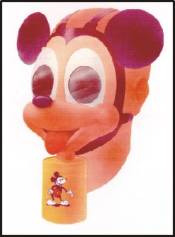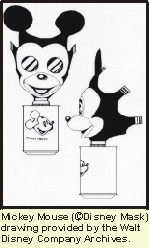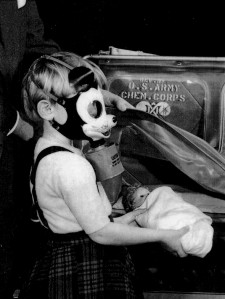| The United States Army Chemical Museum has a
very special gas mask. It looks like Mickey Mouse (©Disney)!! This mask
was produced early in 1942 to protect children in case of a chemical
attack on the United States.
By Major Robert D. Walk On December 7, 1941, the Japanese attacked Pearl
Harbor, Hawaii with massive force that destroyed the battleships of the
Pacific Fleet. In the dark days of early 1942, the US government was
faced with the specter of defeat and gloom. Our military was fighting a
losing battle on all fronts and fears of saboteurs and submarines
attacking the US were high. A critical need existed to protect the
civilian population, especially children, from gas attacks. Hawaii was
of special concern and thousands of US military training masks were
rushed in for the civilian population’s use. No masks were available
to protect children, so the Hawaiian Department used a locally
fabricated expedient that consisted of a hood with bunny ears.
The mask was designed so children would carry it and
wear it as part of a game. This would reduce the fear associated with
wearing a gas mask and hopefully, improve their wear time and, hence,
survivability. The protection of children was a primary concern of all
nations during World War II. Germany had a child’s gas protective crib
for infants and a protective hood for toddlers and children unable to
wear the adult noncombatant mask. The United Kingdom had a similar
program. In the United States, the M1 Infant
The Mickey Mouse Gas Mask was produced as part of the
war production program. The Sun Rubber Company produced approximately
1,000 Mickey Mouse gas masks and earned an Army-Navy ‘E’ for
excellence in wartime production in 1944. Overall, production of the
Noncombatant Gas Masks (and in fact, all gas masks) was one of the most
successful production programs of the war. In fact, production had to be
curtailed early due to the vast quantity produced. Thankfully, no chemical attacks occurred in the United
States. Mickey Mouse Gas Masks were distributed to senior officials and
others during the war as keepsakes. When the war ended, further desire
for the mask vanished. It became an old idea whose time had passed. Very few of the Mickey Mouse gas masks survived. The US
Army Chemical Museum at Fort McClellan, Alabama, has a hand-made
prototype. The 45th Infantry Division Museum, Oklahoma City, Oklahoma,
has a production specimen on permanent display with other gas masks in
the combat support area of the museum. The Walt Disney Archives,
Burbank, California, has a facepiece without ears, lenses, or a
canister, and a mask owned by the founder of the Sun Rubber Company was
on display at the Summit County (Ohio) Historical Society’s "Toys
Made in Summit County" exhibit in 1982. Have you seen one of these
masks? At the time this article was written, Major Robert D. Walk was the Weapons of Mass Destruction Individual and Instructor Training Officer at the US Army Reserve Command. He is a graduate of the Command and General Staff College (Resident and Correspondence), the Combined Arms and Services Staff School, the Chemical Officers Advanced Course, and the Chemical Officers Basic Course. Previous assignments include Commander, 184th Chemical Detachment; Commander, HHC, 59th Ordnance Brigade; Acting Commander, 1st Battalion, 377th Regiment, 95th Division (Institutional Training); S-3, 1st Battalion, 377th Regiment, 95th Division (Institutional Training); S-3, 197th Ordnance Battalion; Chemical Officer, Readiness Group Stewart; and Chemical Officer, 60th Ordnance Group. |


